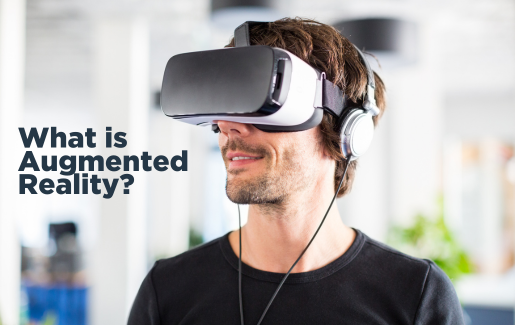 Broadly speaking, innovators have been tinkering with the concept of augmented reality (AR) since the dawn of the information age, when competing movie producers attempted to enhance the cinematic experience by adding odors. AromaRama got to theaters first with the release of The China Wall in December 1959, followed roughly a month later by the debut of Smell-O-Vision with the release of Scent of Mystery. The technology performed poorly, both films flopped, and 40 years later Smell-O-Vision was chosen as one of the "100 Worst Ideas of All Time" by readers of Time magazine.
Broadly speaking, innovators have been tinkering with the concept of augmented reality (AR) since the dawn of the information age, when competing movie producers attempted to enhance the cinematic experience by adding odors. AromaRama got to theaters first with the release of The China Wall in December 1959, followed roughly a month later by the debut of Smell-O-Vision with the release of Scent of Mystery. The technology performed poorly, both films flopped, and 40 years later Smell-O-Vision was chosen as one of the "100 Worst Ideas of All Time" by readers of Time magazine.
Even the worst-laid plans sometimes have a way of hanging around, however, and the intervening decades have refined the basic idea of using digital media or other tools to project sensory stimuli into (or onto) a real-world environment for the purpose of providing an enhanced experience. Professional sports teams sometimes help athletes practice by piping in crowd noise — imagine a basketball player shooting free throws in an empty gym — to simulate the pressure of an actual game.
In a nutshell, AR is any use of technology to deliver virtual information or sensation that enhances the experience of an individual interacting with a physical environment.
How Augmented Reality Works
On a practical level, an AR engineer has to answer two basic questions:
- What do I want to add to the user or consumer experience?
- What tools or systems will I use to accomplish that?
Let's go back to the historical example of Smell-O-Vision. Producer Mike Todd Jr. and designer Hans Laube wanted to improve the experience of watching a movie by engaging the viewer's sense of smell. The mechanism that Laube developed for this was complex. Vials of various scents (such as pipe tobacco) were arrayed on a rotating cartridge in the order that they would be used during the film. The cartridge, synced to the projector, would release each scent into a custom-built delivery system where fans would pass it through pipes to vents beneath every seat in the theater.
(AromaRama was like child's play by comparison, essentially blowing scents into the theater via standard air conditioning ductwork. Sort of like spraying the entire audience in the face, all at once, with a giant can of Febreeze.)
The overall AR process is more or less the same today. Once a decision has been made about how and why to provide an enhanced experience in a physical setting, all that's left is to design and fabricate the delivery system.
Types of AR
There are many different types of AR already in use and there is vast potential to create new varieties from scratch or adapt existing varieties to new uses or formats. Let's look at a few broad categories where AR applications already exist.
Visual Data Transfer
AR is often designed to deliver various useful data to a user by visual overlays using text, video or simple diagrams. One of the earliest AR products was Google Glass, essentially a pair of eyeglasses with interactive lenses. Google Glass was first announced in 2012, and an early prototype was made available to self-selected "Glass Explorers" in 2013.
The idea was that you could receive information about your immediate environment using Google's powerful search tools. Google Glass included a camera, a fingertip touchpad, voice activation technology and more. Imagine a tourist walking down a street in New York City or Los Angeles. They see a restaurant, then they learn about its rating on Yelp or TripAdvisor, or read reviews by other patrons or possibly even find out what's on the menu.
Google Glass was also put to use in medical contexts, including to facilitate live surgical consultations, and to help young mothers learn proper breastfeeding techniques.
Spatial Projection
AR technology is often used to enhance physical environments by projecting images, sound, or other sensory stimuli. Imagine yourself touring a museum and learning about a vanished culture or ancient setting. Instead of simply describing daily life in the Roman city of Pompeii — famously buried in volcanic ash by the eruption of Mount Vesuvius — a docent might use projection of images or sound to place you in a busy market square.
There are already applications in entertainment. Rock and pop stars have used projection technology to enhance the concert-going experience for decades, with increasingly immersive results. Singer-songwriter Taylor Swift designed her career retrospective Eras Tour to include images projected on various surfaces at concert venues to help transport screaming fans through the various stages of her artistic development.
Remote Interaction
The pandemic made many people more open to the idea of going somewhere without actually physically going there. A relatively recent innovation in AR is the creation of web-based "portals" that let users explore and experience remote locations.
The purpose of some portals is simply to spur the imagination. In 2021, beermaker Anheuser-Busch partnered with AR firm Aircards to create a portal to Yosemite National Park in California. There are more practical applications as well: Aircards also partnered with Dell Technologies to use portal technology to host a trade exhibition derailed by COVID precautions.
What Are the Components of AR?
In a very real sense, AR is already in the palm of your hand. We've discussed some of the ways that AR is deployed. AR technology can be custom designed and built from scratch at various levels of complexity. It's quite common, on the other hand, for AR to be grafted onto familiar items that many people carry around with them each day.
PairPlay is an AR app launched in 2021 that is designed to work with your Apple AirPods. The idea behind PairPlay is a sort of self-directed improv and role-playing experience — all you need is your AirPods and a friend. Each of you takes one earbud and then you each respond to simultaneous and slightly different audio prompts.
That same template — take something familiar, add a twist to alter and improve the experience — can be found in many different places. Home exercise equipment like Peloton or NordicTrack often has the option for workout warriors to partner with a remote trainer or coach. Pair that with streaming video and suddenly you're running along a mountain trail in the Swiss Alps, or biking through a jungle in Thailand.
In that sense, there are no standard AR components. Given the right software, AR engineers can use a variety of tools and technologies to achieve their desired outcome.
Industry Applications of AR and Real Life Use Cases
Business and other organizations often use AR apps for training or education. Heads-up display (HUD), the concept (incorporated by the aforementioned Google Glass) of relaying information to individuals without requiring them to look down at a schematic or manual, is a key innovation here. Learners can look directly at a device or mechanism while receiving instructions about how to use it, repair it, configure it and so forth.
AR can also enhance remote collaboration, coworking and conferencing by using various sensory stimuli to enhance the sense of connection among co-workers and relieve the tedium of staring at a grid of faces. Some co-working apps, for example, let you gather with teammates around a virtual water cooler or coffee table, or close a virtual door between yourself and co-workers that cuts off background noise when you need to focus.
Advantages and Disadvantages of AR
There are obvious benefits of using AR touching almost everything we've already discussed. That doesn't mean that there are no drawbacks. Some AR relies on a degree of user cooperation or participation. If a user isn't willing to play along, then the effect can be diminished or lost altogether. To some extent, for example, using your Peloton to whiz along, say, the Pacific Coast Highway in California, is only as immersive as you allow it to be.
There can also be expensive dead ends in development. AR often offers something that users or consumers aren't really looking for. A few years ago, many movie theaters installed seats that would shake or tilt seemingly in response to things happening onscreen. For double the price of a normal movie ticket, you could sit in one. The supposed value-add didn't take, and the idea went away almost as quickly as it showed up.
It can also be difficult to create an AR experience that appeals equally to different individuals. Mass adoption is what drives investment. Yet while some people are willing to embrace AR at the level of implanted technology, others don't even want to interact with something as innocuous as Pokémon GO (the game app that famously lets you discover and capture virtual fantasy creatures in real-world settings).
Where Do We Go from Here?
The future of AR, like its past and present, is bound to include trial and error and produce a mixed bag of results. Many observers see retail sales as an obvious growth sector for AR, with consumers using AR apps to try on clothes, or inspect appliances and furniture. Advertising is another fertile field — consumers from all walks of life should expect to be courted by increasingly immersive sales pitches.
The AR marketplace is bound to be fickle. Remember Google Glass? Consumer sales ended in March and customer support is set to go dark in September. On the other hand, just because something didn't work the first time, that doesn't mean we'll never see it — or smell it — again. Walt Disney was so intrigued by the idea of including scents in film that he almost attempted it for the 1940 release of Fantasia, 20 years before Smell-O-Vision and AromaRama.
The technology did, however, eventually catch on within Disney's Magic Kingdom. The Soarin' flight simulator ride at Disney California Adventure Park has been delighting visitors with its combination of film and scent since 2001. Whatever form it takes in the future, AR seems bound to stick around.
Want to learn about AR and other innovative technologies?
Join CompTIA’s Technology Interest Groups and start a discussion!

 Add CompTIA to your favorite RSS reader
Add CompTIA to your favorite RSS reader

